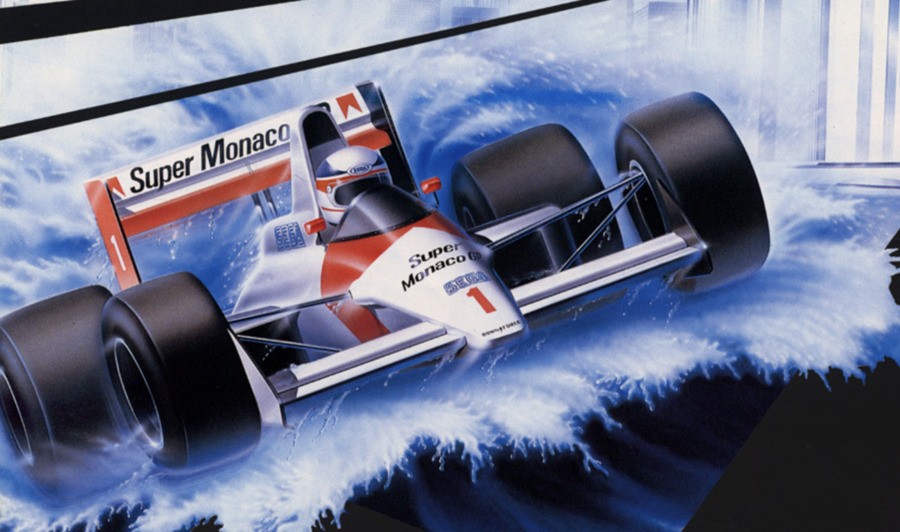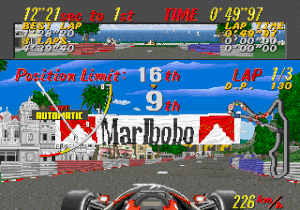
The video game industry has matured to the point where any potential infringements of copyright are routinely avoided in fear of being taken to court, but in its earlier years, companies were less cautious about this kind of thing – and nowhere will you find a more obvious example of this than Sega's 1989 Super-Scaler arcade hit, Super Monaco GP.
In an attempt to ensure maximum authenticity, Sega included the logos of famous Formula One sponsors in the game without permission, subtly modifying them in an effort to avoid any issues. For example, 'Fosters' became 'Hosters', 'Ford' was 'Fodo', 'Mobil 1' was 'Modil 2', 'Marlboro' became 'Marlbobo' and 'Canon' was reimagined as 'Conan'. All of these sponsors were present in contemporary Formula One coverage, so it made sense on one level to include them, even in modified form; it all lent to the game's appeal. The arcade unit's colouring was also based on the livery of the title-winning F1 outfit McLaren, which was, in turn, inspired by the famous 'red roof' branding of Marlboro cigarettes, as Marlboro was the team's main sponsor. For good measure, the game's pit girls were infamously based on digitised (and unauthorised) likenesses of Playboy models Mercy Rooney and Claire Rambeau – edited to cover their modesty with swimsuits. Looking back on this today, it's impossible to shake the feeling that Sega was really pushing it.

However, for the time, none of this was really against the norm – video game designers had been ripping off the likes of Arnie and Stallone for years by this point – but the fact that real-world brands were being referenced became an issue. The first signs of a problem came when 'Doctors Ought to Care' – an anti-smoking group – complained about the 'Marlbobo' sponsor to the U.S. Federal Trade Commission; the game's commercial success led to the suggestion that it was advertising cigarettes to children (a point which seemed to ignore the fact that any child who watched Formula One was being exposed to the real sponsorship).
Following this complaint, tobacco company Philip Morris – which owns the Marlboro brand – hit Sega with a cease and desist order in November 1989. To its credit, the Japanese company responded quickly, agreeing to create a conversation kit for the arcade machine which removed the offending brands. This was issued in March of 1990, and famously replaced the sponsors with banners promoting Flicky, another Sega arcade release.
Sega defended the use of the 'Marlbobo' imagery in the game, claiming that it "intended and believes that all the alleged use of the marks in the game was for the sole purpose of adding realism in the background of the game to simulate real-life locations or racing cars." For its part, Philip Morris exploited the fracas to gain positive press in the fight against underage smoking. John Nelson, the company's vice president of corporate affairs, said: "We want to demonstrate to everybody we are committed to stopping kids from smoking."

Unfortunately for Sega, this was not the end of the issue. Not every Super Monaco GP unit in the wild was updated with the conversion kit, which meant that the offending 'Marlbobo' branding was still present in many amusement arcades. Philip Morris therefore sued Sega in February 1991 – and, as if to prove it wasn't discriminating, also took legal action against Sega's arcade rival Namco over its use of the Marlboro brand in 1987's Final Lap coin-op.
Nothing less than a total recall of every Super Monaco GP arcade unit would please Philip Morris' lawyers, as well as financial compensation and the destruction of all promotional material related to the game. This was an unrealistic demand, and it came as no great shock when the two firms settled the issue in May 1992 – with the condition that Sega ran advertisements in leading arcade industry magazines offering to replace the chips in the arcade version with ones that removed the advertising, with the offer of $200 to all operators who did so and returned the offending chips. By the time the game was ported to the Sega Mega Drive and Master System home consoles, the Marlboro imagery was gone, and the team in the game based on McLaren would sport a yellow and red livery rather than a white and red one.
Not everyone was convinced Philip Morris' actions were entirely about protecting children from cigarette advertising; Dr. John W. Richards of the Medical College of Georgia said: "It’s a hoax. It’s one more of Philip Morris’s cruel hoaxes." Richards was president of the aforementioned activist group 'Doctors Ought to Care' and felt that the lawsuit was little more than a publicity stunt to gain the Marlboro brand some additional exposure and positive press.
Over time, the video game industry has become a little more responsible when it comes to ripping off existing brands and has also taken steps to ensure that tobacco advertising doesn't creep into games which are played by youngsters. However, Super Monaco GP is an example of just how footloose and fancy-free the industry used to be – all in the name of authenticity.






Comments 3
How about revenge of Shinobi 🥷 on the megadrive? That had spidy, batman and Godzilla fighting as bosses.
Sega once again at its best.
I notice that the Ferrari logo has been replaced on the red car in Outrun on the megadrive mini 2 so it appears as though Sega has learnt from its past mistakes.
I so wanted a 3DS Ages version of this Arcade game, such a missed opportunity.
I could sure go for a Marlbobo right now …
Show Comments
Leave A Comment
Hold on there, you need to login to post a comment...